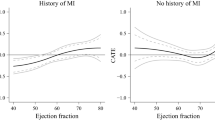Abstract
Studies using coronary angiography patients as the study population to assess etiologic relationships are vulnerable to bias produced by patient selection factors, but the direction and magnitude of the bias in any particular study are uncertain. Partly for this reason, some authors have questioned the use of angiography data for studies of etiology. Nevertheless, this type of data continues to be used in etiologic studies. Therefore, in this paper a conceptual framework is described to quantify the degree of bias under different assumptions about the process whereby patients are selected for angiography. The direction and degree of bias depend on the pattern of patient selection, as well as the measure of association used (e.g., the risk ratio or odds ratio). One method is then described, based on assessing how physicians refer patients to angiography, which estimates the degree of bias produced by selection factors. This study is limited to the situation of a two-level risk factor (e.g., type A/B behavior) in relation to a two-level outcome measure (e.g., significant coronary artery occlusion versus no significant coronary artery occlusion). While type A/B behavior is used as an example in this paper, the concepts apply to any behavioral or nonbehavioral predictor variable.
Similar content being viewed by others
References
Dimsdale, J. E., Hackett, T. P., Catanzano, D. M., and White, P. M. (1979). The relationship between diverse measures for Type A personality and coronary angiographic findings.J. Psychosom Res. 23: 289–293.
Dimsdale, J. E., Hackett, T. P., Hutter, A. M., and Block, P. C. (1980). The risk of Type A mediated coronary artery disease in different populations.Psychosom. Med. 42: 55062.
Frank, K. A., Heller, S. S., Kornfeld, D. S., Sporn, A. A., and Weiss, M. B. (1978). Type A behavior and coronary angiographic findings.JAMA 240: 761–763.
Fried, L. P., and Pearson, T. A. (1987). The association of risk factors with arteriographically defined coronary artery disease: What is the appropriate control group?Am J. Epidermiol. 125: 844–853.
Kleinbaum, D. G., Morgenstern, H., and Kupper, L. L. (1981). Selection bias in epidemilogic studies.Am. J. Epidemiol. 113: 451–463.
Langeluddecke, P., Fulcher, G., Jones, M., and Tennant. C. (1988). Type, A behavior and coronary atherosclerosis.J. Psychosom. Res. 32: 77–84.
Pearson, T. A. (1983). Coronary arteriography in the study of the epidemiology of coronary artery disease.Epidemiol. Rev. 6: 140–166.
Pickering, T. G. (1985). Should studies of patients undergoing coronary angiography be used to evaluate the role of behavioral risk factor for coronary heart disease?J. Behav. Med. 8: 203–213.
Williams, R. B., Barefoot, J. C., Haney, T. L., Harrell, F. E., Blumenthal, J. A., Pryor, D. B., and Peterson, B. (1988). Type A behavior and angiographically documented coronary atherosclerosis in a sample of 2,289 patients.Psychosom. Med. 50: 139–152.
Zyzanski, S. J., Jenkins, C. D., Ryan, T. J., Flessas, A., and Evcrist, M. (1976). Psychological correlates of coronary angiographic findings.Arch. Intern. Med. 136: 1234–1237.
Author information
Authors and Affiliations
Additional information
This work was funded in part by The National Institutes of Health, U.S. Department of Health and Human Services under Grants HL26235 and T32 HL07365.
Rights and permissions
About this article
Cite this article
Ragland, D.R., Helmer, D.C. & Seeman, T.E. Patient selection factors in angiographic studies: A conceptual formulation and empirical test. J Behav Med 14, 541–553 (1991). https://doi.org/10.1007/BF00867169
Issue Date:
DOI: https://doi.org/10.1007/BF00867169




